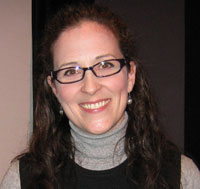Designing in a Cross-Cultural Context: Lessons Learned
 Have you ever been asked to do something only to discover it's not the best way to deal with the situation? Throw in a language barrier and you have the situation Kara Pecknold found herself in in early 2008. As part of her thesis project she took an internship to develop a website for a Rwandan weavers cooperative. After observing the situation firsthand she experienced a mind shift. In her presentation: Designing in a Cross-Cultural Context: Lessons Learned, given to the Vancouver User Experience (VanUE) group on March 16, 2010, Pecknold told the story.
Have you ever been asked to do something only to discover it's not the best way to deal with the situation? Throw in a language barrier and you have the situation Kara Pecknold found herself in in early 2008. As part of her thesis project she took an internship to develop a website for a Rwandan weavers cooperative. After observing the situation firsthand she experienced a mind shift. In her presentation: Designing in a Cross-Cultural Context: Lessons Learned, given to the Vancouver User Experience (VanUE) group on March 16, 2010, Pecknold told the story.
The Covaga is a women's weaving cooperative in Rwanda that extracts weaving fibre from the water hyacinth and turns it into a product. The water hyacinth is an invasive species, so its harvesting and subsequent use as weaving fibre serves a dual useful purpose. The goal of Pecknold's internship was to design a website to facilitate the sales of these woven goods to the world.
Part of all website design projects is working with the client to create a design that meets their needs. Although Pecknold had a translator, language and cultural differences were an issue. This wasn't the unexpected part. Dealing with this issue was part of Pecknold's research. Using and extending the IDEO Human Centered Design Toolkit for NGOs Pecknold worked to determine what was important to these women.
Pecknold has documented the process she used at http://cargocollective.com/karapecknold. Most of the VanUE presentation was a detailed case study of the process, and it's fascinating. I recommend taking a look at her website, it covers the information better than I can in this post. It didn't escape the notice of the room that these techniques would work in any situation where designer and client are trying to come to a common understanding, regardless of speaking the same language or not!
Pecknold soon realized a website wasn't the best way to help these woman. Although many parts of Africa are in a position to utilize technology, it's by no means ubiquitous. These women had no computers, electricity, Internet, or cell phones, making it extremely difficult for them to maintain a website. Determined to give them something of immediate value, Pecknold reframed the deliverables and gave them a starting point for creating a brand identity for their product. The most tangible result of this was a new logo. And yes, she did deliver a website, too.

Covaga Product with Branding
Photo © Kara Pecknold, used with permission
Pecknold then went on to give broader examples of how this kind of co-design process could be used to help other Africans help themselves. These were real examples of actual businesses, not hand waving. When it comes to Africa I'm used to images of war, conflict, or squalor. It was heartening to see a class of people who not only weren't destitute (though they are poor by our standards), but were trying to better their situation in productive ways. It's easy to see how a co-design consulting style of assistance might better serve.
After the detail of the first part of the presentation, this jump to the macro level almost felt like a new presentation. It was no less interesting for the switch-up, and intriguing, since it's another tool for helping people product a sustainable result.
If you have an opportunity to hear Kara Pecknold speak, take it. She's knowledgeable, articulate, and has gathered some experiences worth hearing about.
Websites:

Comments
An Update
I exchanged a couple of emails with Kara when I asked her permission to use the product photo. She mentioned that she had an opportunity to return for a visit. She's written a quick update if you want to know more: Visiting Covaga